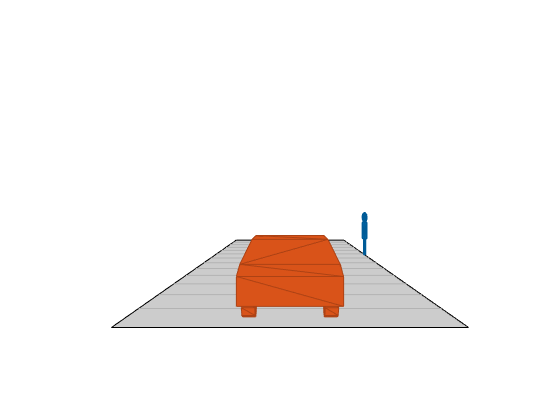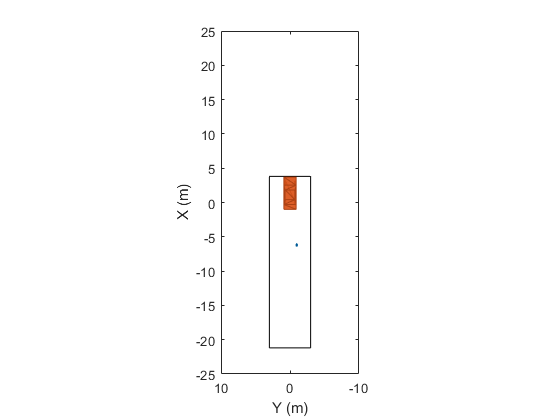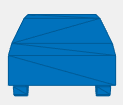targetMeshes
Mesh vertices and faces relative to specific actor
Description
Examples
Display actors in a driving scenario by using their mesh representations instead of their cuboid representations.
Create a driving scenario, and add a 25-meter straight road to the scenario.
scenario = drivingScenario; roadcenters = [0 0 0; 25 0 0]; road(scenario,roadcenters);
Add a pedestrian and a vehicle to the scenario. Specify the mesh dimensions of the actors using prebuilt meshes.
Specify the pedestrian mesh as a
driving.scenario.pedestrianMeshobject.Specify the vehicle mesh as a
driving.scenario.carMeshobject.
p = actor(scenario,'ClassID',4, ... 'Length',0.2,'Width',0.4, ... 'Height',1.7,'Mesh',driving.scenario.pedestrianMesh); v = vehicle(scenario,'ClassID',1, ... 'Mesh',driving.scenario.carMesh);
Add trajectories for the pedestrian and vehicle.
Specify for the pedestrian to cross the road at 1 meter per second.
Specify for the vehicle to follow the road at 10 meters per second.
waypointsP = [15 -3 0; 15 3 0]; speedP = 1; smoothTrajectory(p,waypointsP,speedP); wayPointsV = [v.RearOverhang 0 0; (25 - v.Length + v.RearOverhang) 0 0]; speedV = 10; smoothTrajectory(v,wayPointsV,speedV)
Add an egocentric plot for the vehicle. Turn the display of meshes on.
chasePlot(v,'Meshes','on')

Create a bird's-eye plot in which to display the meshes. Also create a mesh plotter and lane boundary plotter. Then run the simulation loop.
Obtain the road boundaries of the road the vehicle is on.
Obtain the mesh vertices, faces, and colors of the actor meshes, with positions relative to the vehicle.
Plot the road boundaries and actor meshes on the bird's-eye plot.
Pause the scenario to allow time for the plots to update. The chase plot updates every time you advance the scenario.
bep = birdsEyePlot('XLim',[-25 25],'YLim',[-10 10]); mPlotter = meshPlotter(bep); lbPlotter = laneBoundaryPlotter(bep); legend('off') while advance(scenario) rb = roadBoundaries(v); [vertices,faces,colors] = targetMeshes(v); plotLaneBoundary(lbPlotter,rb) plotMesh(mPlotter,vertices,faces,'Color',colors) pause(0.01) end


Input Arguments
Actor belonging to a drivingScenario object, specified as an
Actor or Vehicle object. To create these objects, use the
actor and vehicle functions, respectively.
Output Arguments
Mesh vertices of each actor, returned as an N-element cell array, where N is the number of actors.
Each element in vertices must be a V-by-3
real-valued matrix containing the vertices of an actor, where:
V is the number of vertices.
Each row defines the 3-D (x,y,z) position of a vertex. The vertex positions are relative to the position of the input actor
ac. Units are in meters.
Mesh faces of each actor, returned as an N-element cell array, where N is the number of actors.
Each element in faces must be an F-by-3
integer-valued matrix containing the faces of an actor, where:
F is the number of faces.
Each row defines a triangle of vertex IDs that make up the face. The vertex IDs correspond to row numbers within
vertices.
Suppose the first face of the ith element of
faces has these vertex IDs.
faces{i}(1,:)ans =
1 2 3In the ith element of vertices, rows 1, 2,
and 3 contain the (x, y, z)
positions of the vertices that make up this face.
vertices{i}(1:3,:)ans =
3.7000 0.9000 0.8574
3.7000 -0.9000 0.8574
3.7000 -0.9000 0.3149Color of the mesh faces for each actor, returned as an N-by-3
matrix of RGB triplets. N is the number of actors and is equal to the
number of elements in vertices and
faces.
The ith row of colors is the RGB color value
of the faces in the ith element of faces. The
function applies the same color to all mesh faces of an actor.
An RGB triplet is a three-element row vector whose elements specify the intensities
of the red, green, and blue components of the color. The intensities must be in the
range [0, 1]. For example, [0.4 0.6 0.7].
More About
In driving scenarios, a mesh is a triangle-based 3-D representation of an object. Mesh representations of objects are more detailed than the default cuboid (box-shaped) representations of objects. Meshes are useful for generating synthetic point cloud data from a driving scenario.
This table shows the difference between a cuboid representation and a mesh representation of a vehicle in a driving scenario.
| Cuboid | Mesh |
|---|---|
|
|
Version History
Introduced in R2020b
MATLAB Command
You clicked a link that corresponds to this MATLAB command:
Run the command by entering it in the MATLAB Command Window. Web browsers do not support MATLAB commands.
选择网站
选择网站以获取翻译的可用内容,以及查看当地活动和优惠。根据您的位置,我们建议您选择:。
您也可以从以下列表中选择网站:
如何获得最佳网站性能
选择中国网站(中文或英文)以获得最佳网站性能。其他 MathWorks 国家/地区网站并未针对您所在位置的访问进行优化。
美洲
- América Latina (Español)
- Canada (English)
- United States (English)
欧洲
- Belgium (English)
- Denmark (English)
- Deutschland (Deutsch)
- España (Español)
- Finland (English)
- France (Français)
- Ireland (English)
- Italia (Italiano)
- Luxembourg (English)
- Netherlands (English)
- Norway (English)
- Österreich (Deutsch)
- Portugal (English)
- Sweden (English)
- Switzerland
- United Kingdom (English)

